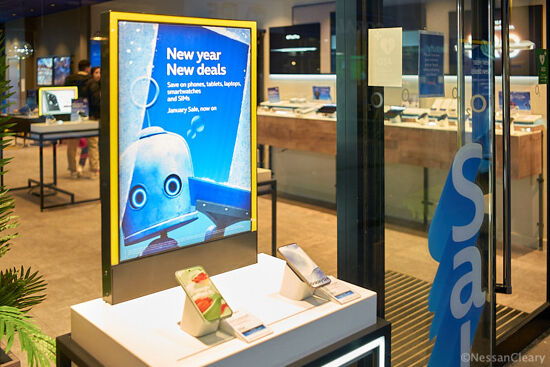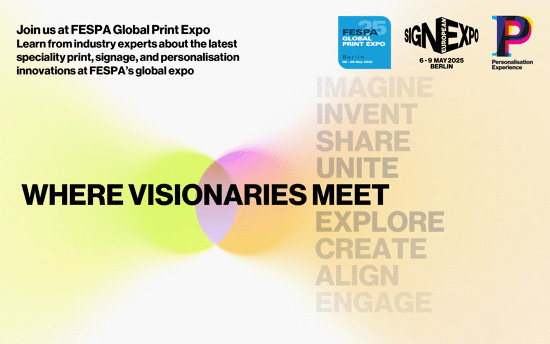How to choose the right ink for the best print output
<br><br><br><br><br><br>Normally the key to the success of every print job, whether analogue or digital, depends on the correct mix of media and ink. <br><br><br><br><br><br>
While the material is normally pretty straightforward in terms of end application, performance and appearance are reliant on getting the ink chemistry right and this can make or break a job, both in quality and cost.
A customer visiting a Print Service Provider (PSP) will usually have some idea about what they want in terms of a printed product. However, because it simply isn’t possible for every supplier to own the full gamut of machines to cover every eventuality, either the client must compromise or take their business elsewhere.
Since the acceptance of digital print and computerised front-end systems, new doors have opened and a vast range of applications can now be produced without financial or time penalties when only one-offs and short runs are required.
Early technologies were primarily aqueous-based inkjet or thermal transfer and this meant many jobs could be produced in a practical manner without time-consuming set-up which impacted on low volume and personalised requirements. Today all this has changed and there are few products that cannot be generated, thanks to current technologies.
Mainlining
Since inkjet first became mainstream, technology has evolved so that nearly every type of substrate can be used. Since digital print’s initial growth period, ink chemistries have become available for nearly every digital printing and substrate combination.
Formulations vary widely depending on material type and overall expectations. For example, aqueous-based printers are still widely used for very high quality photographic and fine art applications.
Their inks generally meet requirements for archiving when used with the correct papers. Called giclée in some circles, the bulk of work produced in this category still relies almost exclusively on the early ink formulations created for the fine quality digital prints artists and photographers prefer.
The largest and most diverse segment for wide-format digital print is signs, displays, point-of-purchase, retail and, increasingly, interior décor. This is where, within each category, the greatest number of ink options are available.
It is relatively easy to divide these categories into tidy compartments containing solvent-based, UV-curable, latex and aqueous-based options, but it’s less simple to determine which ink is best for which job. Printing direct to rigid substrates is relatively straightforward because, for adhesion purposes, the only real option is UV-curable chemistry.
Alternative formulations require a heat source for drying which can compromise the media. Typical display materials would buckle and, even, melt at the high temperatures needed, so early flat-bed printers attempting to lay down solvent-based inks for the most part failed.
Addictions
Specific ink formulations are required to provide the necessary elasticity and adhesion for wrapping applications.
With UV-curable inks becoming the de facto option for printing direct to rigid substrates, their popularity has extended to flexible media. However solvent-based inks are able to key, or bond, with the media surface and deliver a durable finish.
Despite their popularity and relatively low cost for producing roll-fed applications, the downside of original solvent printers lay in the hazardous ingredients of the inks and their emissions. When used in retail environments, for example, there was always the risk that the smell of solvent as it evaporated could compromise merchandise.
Milder formulations that provide benefits in terms of material adhesion, durability and good colour handling have countered some of the hazards of solvents.
Modestly priced machines that work with coated and uncoated stocks are available but, because their chemistries contain fewer solvents, their keying capabilities are less efficient. Jobs printed with these inks normally are laminated to protect them, which can also improve and add vibrancy to the finished appearance.
On the trail of generating an ink formulation which covered all flexible material requirements, the next chemistry to make an impact was latex. To all intents and purposes, latex could be treated much as an aqueous-based ink. While the environmental benefits of the ink were obvious, early machines required a high concentration of heat both for pre- and post-curing.
But, once dried, prints could be laminated immediately and improvements to the formulation have now removed most of the latex’s initial unwanted idiosyncrasies. These included a difficulty in maintaining colour uniformity across the width of the print and providing a wide enough gamut to reproduce output that was fit for purpose for photographic quality.
In terms of UV-curable chemistries, and in line with the growth in popularity of LED rather than mercury arc curing lamps, formulations have now proved their versatility across a vast range of different media types. Today’s inks work with very thin stocks, rigid substrates and those requiring high levels of elasticity.
The last word
Different inks do different jobs with chemistries designed to handle all types of media.
But print buyers and end users must have the final say when it comes to finish and job suitability, considering durability, coating options and compliance with safety standards such as those required for wall coverings in hospitals, schools and some commercial environments.
Particularly when working with flexible materials, the choice of ink is crucial when it comes to meeting safety and environmental standards.
It is also essential to include consider textile options when planning a wide-format digital printing project. Inevitably there was going to be a crossover in technologies with dye sublimation and dispersed ink chemistries challenging the roll-fed market.
This has brought options for many display applications suitable both for interior and exterior use. Although there are acid and reactive dyes, plus new pigmented ink formulations, used widely within the fashion and furnishing arenas, soft signs are generally produced with sublimation processes.
But materials should be at least 50% polyester and the production workflow must incorporate a fixation or calendaring unit for sublimation to occur so that the dye forms a permanent bond with the fabric or polyester coating.
However, there are huge logistical advantages in using comparatively lightweight textiles for displays. There are also environmental benefits because the dyes are water-based and many polyesters can be recycled.
For average end users, there is normally little need to get involved in which ink type should be used for a job: the PSP should make sure that the right marriage of inks and materials will yield the desired result. However, more savvy clients will learn that all inks are not equal and that the price of an order should reflect the complexity and expectation of the chemistry being used.
There is little point in paying a premium price for a highly durable job when the print is only going to be used for a couple of days. Likewise, where quality overall and text detail are both vital, the print engine and the ink used should be able to generate optimum results to match brand requirements.
Make your choice
Choosing the right ink requires solid thought about the application it is to serve, the formulation can easily make or break a job.
No one will complain if digital prints exceed expectations but bad results are remembered. Print buyers are often in the unenviable position of being challenged by clients to get the best of all worlds in terms of price, turnaround and versatility.
There is no such thing as a one size fits all ink, just as there is no single material for all applications. End-users must consider the exact requirements for the final product and make decisions based on performance and suitability, rather than specifying a particular chemistry simply because it happens to be in vogue. sWhat’s right for one order might not be ideal for the next.
But the huge advantage of inkjet printing is that it offers solutions that meet virtually all needs.
FESPA 2017 to analyse the digital ink market
With so many choices of ink in the digital ink market, selecting the best product for a certain job or piece of machinery is no easy task.
If you opt for a cheaper option that does not offer the same quality of more established inks, then you run the risk of producing work that is not up to the quality that customers demand. However, those keen to use quality inks in order to achieve a high quality output are well catered for, with a number of respected suppliers in the market stocking such products.
Taking place from May 8-12 at the Hamburg Messe, FESPA 2017 will this year play host to a number of those companies, each as keen as the other to show off their latest digital ink products and solutions to the thousands expected to attend this Spring.
For more information on the show, the companies that will exhibit and to sign up to attend as a visitor, please visit: www.fespa2017.com
Delegates can save 70€ entry fee to the exhibition by registering via the website and quoting reference code: FESG702. Discover how a visit to FESPA 2017 can benefit your business and register today.
Topics
Interested in joining our community?
Enquire today about joining your local FESPA Association or FESPA Direct
Recent news

Vote now for the FESPA Awards’ People’s Choice Award!
The voting for the prestigious People's Choice FESPA Award is now open until 7th February where those in the industry have the opportunity to vote for their favourite entries, celebrating the exceptional talent in the industry.
.png?width=550)
FESPA MIddle East 2025 - Day 3 Highlights
The third day of FESPA Middle East, 22 January 2025, featured hundreds of professionals visiting the show to see the latest solutions and innovations in speciality print and signage.

The rise of digital screens
Nessan Cleary discusses the increasing use of digital screen in retail shops which have both pros and cons. They can be cost-effective with a variety of different technologies and resolutions that can be used and reduces the amount of short term printing required. However, they do require high amounts of energy to run. Nessan goes into further detail of the pros and cons in this article.

FESPA 2025: Where Visionaries Meet
Michael Ryan, Head of Global Business Development and Global Print Expo shares how the upcoming FESPA Global Print Expo, European Sign Expo and Personalisation Experience shows will be the meeting point where visionaries meet. Michael shares the upcoming features that will be present at these shows.